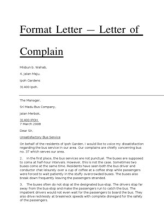 A letter of complaint is a formal document written to address a dissatisfaction. If written to a school, it maybe written by either a student or a parent. The guidelines to writing a successful complaint letter apply in both cases and maybe listed down s follows:
A letter of complaint is a formal document written to address a dissatisfaction. If written to a school, it maybe written by either a student or a parent. The guidelines to writing a successful complaint letter apply in both cases and maybe listed down s follows:
1. Before writing the final letter, make a draft outlining what is being complained about and explain why it needs to be resolved. Explain how it a problem and how it affects you (if a student) or your child (if a parent). This is important as it aids in understanding what you are complaining about. It also makes writing the actual letter easy and quick. It is also very important to consult other students and sampling their views concerning the complaint.
2. Make sure the letter is addressed to the right person– whether the principal, games tutor or deputy principal. If the letter is sent through a school department before getting to the intended recipient, it should be indicated. Example: To the principal, Through the sports department.
3. When writing the letter, go straight to the point. The reason of complaining should be outlined in the first line. It is however important to introduce yourself first. Example: My name is(name) and I am writing to complain about poor attendance of our (subject name) teacher.
Give all details of the problem in a very precise way for easy understanding by the recipient. Remember to explain how the mentioned problem affects you or the class in general.
4. Always use a polite tone when writing. The recipient would be more willing to help if spoken to in a nice way. However, be authoritative so that your complaint is viewed as a serious one. Do not write a letter of complain when angry. Calm down then write when completely composed. This ensures your tone is polite and your complaint has no swear or offensive words.
5.Use a formal language. Avoid any instances of slang or offensive words. Do not include exaggerating words which makes the complaint informal. Do not to be too personal about the problem.
6. Propose a solution after explaining the problem. Suggest a meeting with the principal or whoever is responsible for solving the issue. It is also advisable to say that the issue need be resolved quickly and say why a quick solution is important. Include a few opinions of other students or those of your child.
7. Check the grammar and correct any spelling mistakes. If possible, make two copies so that you remain with one for reference.
8. If in a position to do so, take the letter to the recipient personally. If not,
hand it to trusted channel (maybe a teacher or an adult). Make sure the letter is in an envelope as this makes the complaint latter official.
9. Make a follow up if you receive no response after a reasonable period of time. This may include physically meeting the principal (or the recipient) and raising the concern.